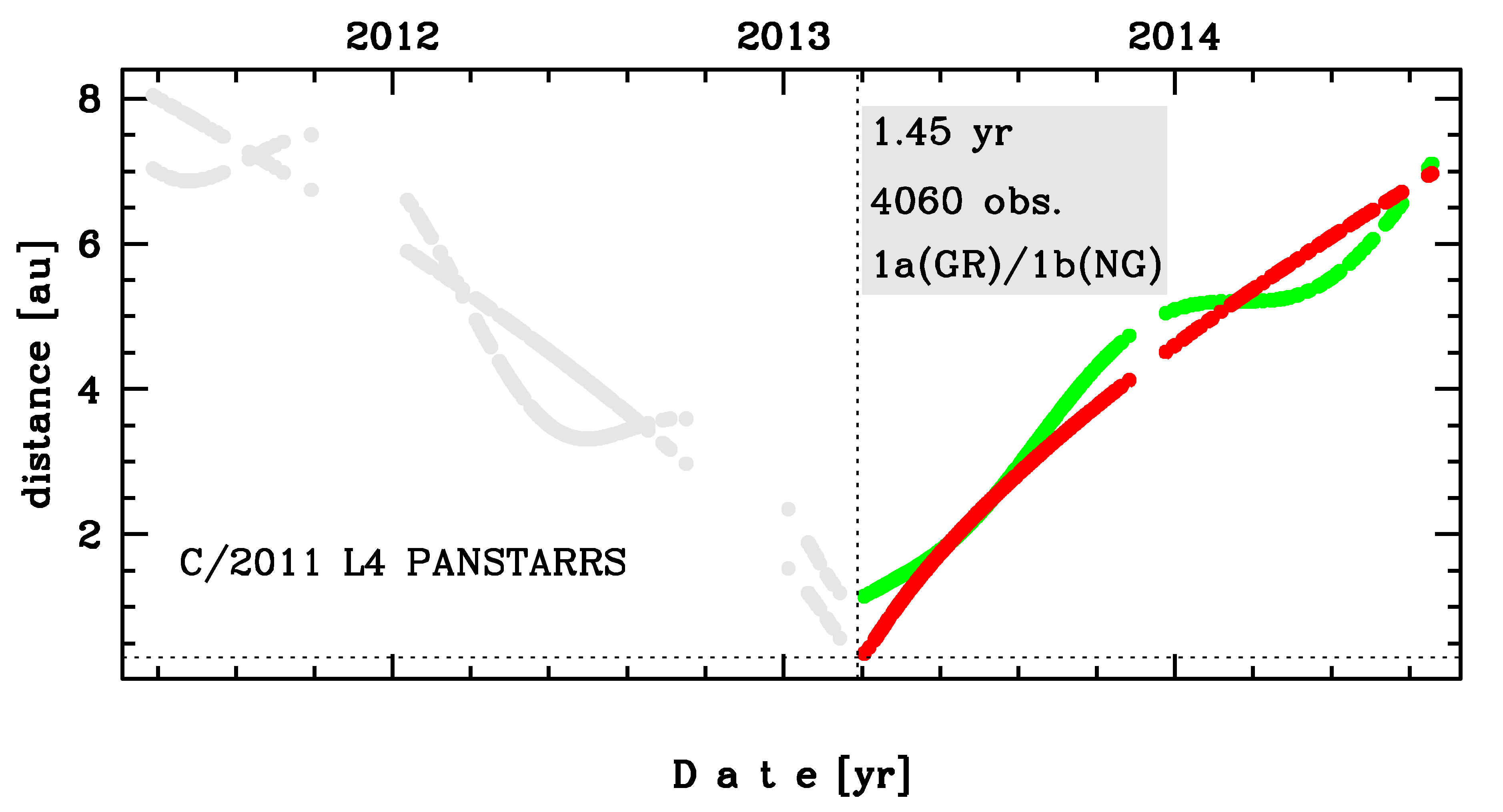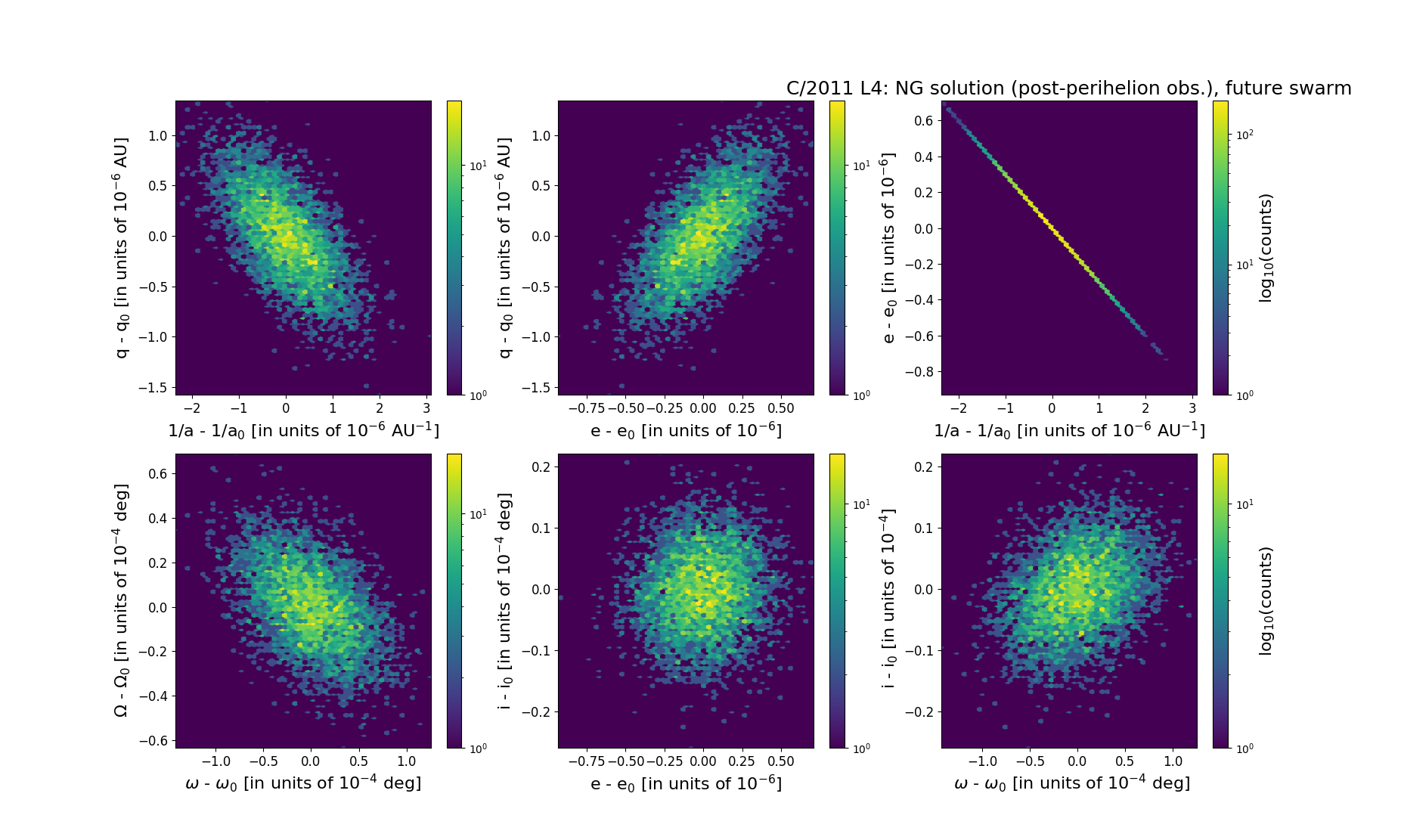C/2011 L4 PANSTARRS
more info
Comet C/2011 L4 was discovered on 6 June 2011 with Pan-STARRS 1 telescope (Haleakala); that is about a year and 9 months before its perihelion passage. Next, pre-discovery images of the comet taken on 21 May (Pan-STARRS 1), 24 May (Mt. Lemmon Survey), and 30 May (iTelescope Observatory, Mayhill), 2011 were found. The comet was observed until 27 August 2014.
Comet had its closest approach to the Earth on 5 March 2013 (1.097 au), 5 days before its perihelion passage.
Preferred solution given here is based on data spanning over 3.27 yr in a range of heliocentric distances: 3.27 au – 0.302 au (perihelion) – 6.97 au. The non-gravitational solution was chosen as preferred orbit; however, uncertainties of NG parameters are relatively large. Additionally, there are two further nongravitational solutions: NG orbit for pre-perihelion arc of data, and NG orbit based on post-perihelion data. All solutions (NG and GR type) give a narrow range of original 1/a values from 29.7 to 32.0 in units of 10-6 au-1.
This Oort spike comet suffers moderate planetary perturbations during its passage through the planetary system; these perturbations lead to a more tight future orbit (see future barycentric orbits).
See also Królikowska 2020.
Comet had its closest approach to the Earth on 5 March 2013 (1.097 au), 5 days before its perihelion passage.
Preferred solution given here is based on data spanning over 3.27 yr in a range of heliocentric distances: 3.27 au – 0.302 au (perihelion) – 6.97 au. The non-gravitational solution was chosen as preferred orbit; however, uncertainties of NG parameters are relatively large. Additionally, there are two further nongravitational solutions: NG orbit for pre-perihelion arc of data, and NG orbit based on post-perihelion data. All solutions (NG and GR type) give a narrow range of original 1/a values from 29.7 to 32.0 in units of 10-6 au-1.
This Oort spike comet suffers moderate planetary perturbations during its passage through the planetary system; these perturbations lead to a more tight future orbit (see future barycentric orbits).
See also Królikowska 2020.
| solution description | ||
|---|---|---|
| number of observations | 4060 | |
| data interval | 2013 03 16 – 2014 08 27 | |
| data arc selection | data generally limited to post-perihelion (POS) | |
| range of heliocentric distances | 0.35 au – 6.97au | |
| type of model of motion | NS - non-gravitational orbits for standard g(r) | |
| data weighting | YES | |
| number of residuals | 8045 | |
| RMS [arcseconds] | 0.44 | |
| orbit quality class | 1b | |
| orbital elements (barycentric ecliptic J2000) | ||
|---|---|---|
| Epoch | 2315 01 12 | |
| perihelion date | 2013 03 10.30425446 | ± 0.00002875 |
| perihelion distance [au] | 0.30087436 | ± 0.00000042 |
| eccentricity | 0.99987097 | ± 0.00000021 |
| argument of perihelion [°] | 333.601353 | ± 0.000038 |
| ascending node [°] | 65.677789 | ± 0.000018 |
| inclination [°] | 84.236247 | ± 0.000006 |
| reciprocal semi-major axis [10-6 au-1] | 428.85 | ± 0.71 |
| file containing 5001 VCs swarm |
|---|
| 2011l4rn.bpl |

